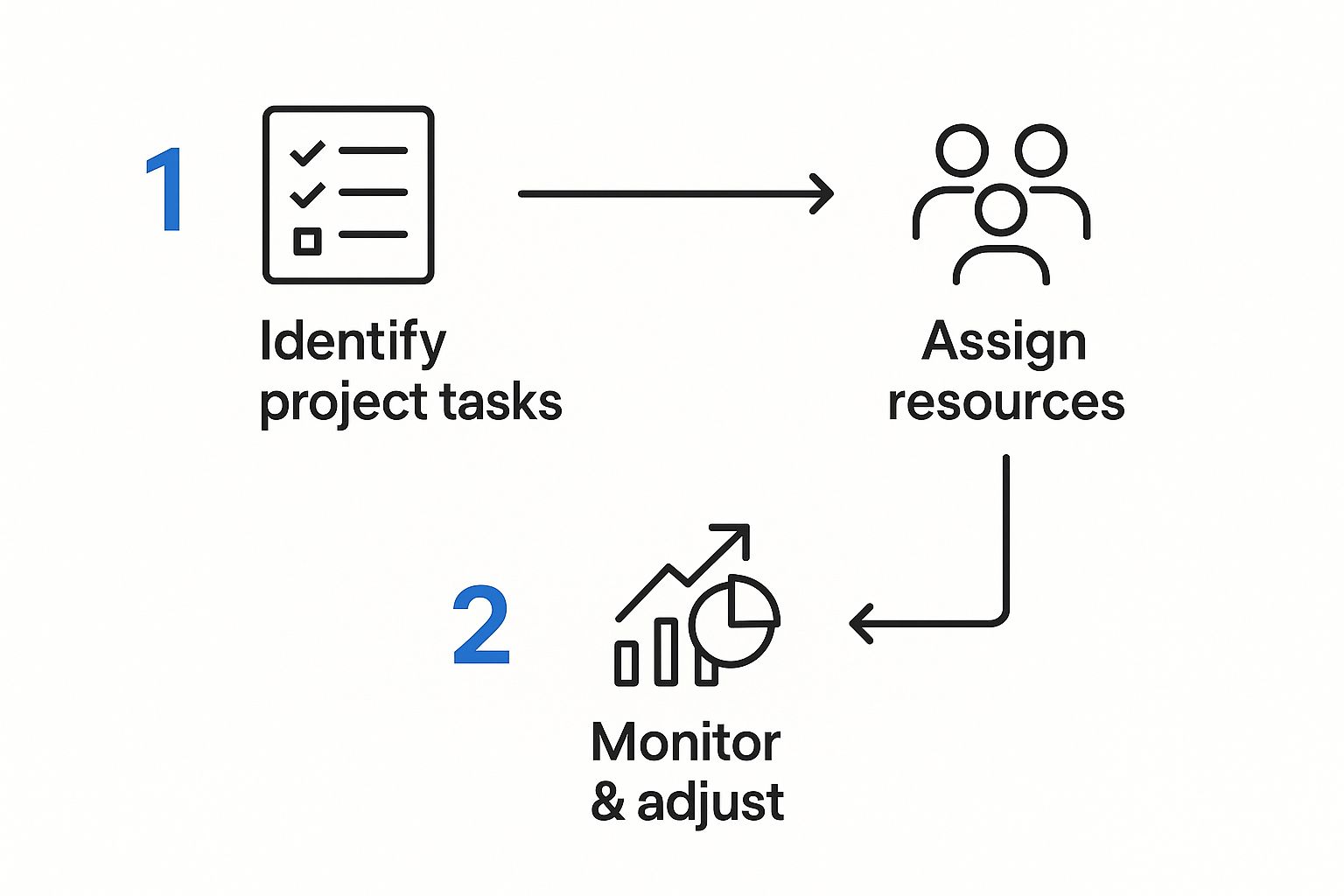At its heart, project management resource allocation is about getting the right people, equipment, and money to the right place at the right time. It sounds simple, but it's the bedrock of any successful project, preventing those all-too-common delays and budget blowouts.
Why Resource Allocation Can Make or Break Your Project

Think of it like cooking a complex meal. You can have the best ingredients in the world, but if you don't know the quantities or when to add them, you’re headed for disaster. Projects are no different. You can have the most talented team, but if they're not allocated correctly, you're setting them up to fail.
Resource allocation is the invisible engine that drives a project. Get it right, and you'll see tasks ticked off efficiently, budgets stay healthy, and deadlines get hit. But when it's overlooked, the project can quickly unravel into chaos.
The Real Costs of Mismanagement
Flawed resource management isn't just inefficient; it sends shockwaves through the entire project. Team morale, client satisfaction, and the final budget all take a hit.
We’ve all seen it happen. Let's look at some common pitfalls:
- Chronic Overallocation: That star developer who's assigned to three critical projects at once? It feels productive, but it’s a one-way ticket to burnout. The quality of their work will eventually drop, mistakes will creep in, and you'll be lucky if they don't start looking for another job.
- Persistent Underallocation: What about the junior marketer with not enough on their plate? You’re not just wasting salary; you’re crushing their motivation and stunting their growth. Good people won't stick around if they're not being challenged.
- Skills Mismatch: Putting a highly analytical person in charge of a creative brainstorming session is a classic square-peg-in-a-round-hole problem. It wastes their true talents, leading to mediocre results and a frustrated employee.
These small errors snowball into major problems. In fact, within the UK project management scene, about 20% of a project manager’s time is spent just trying to juggle resources. And yet, poor allocation is still the main reason why 23% of projects miss their deadlines.
The numbers don't lie. Overallocated team members are a staggering 73% more likely to make errors, while underused staff are 50% more likely to leave the company. If you're curious, you can dig into more project management statistics to see the broader trends.
The core challenge isn't just about filling slots on a calendar. It's about strategically deploying your most valuable assets to maximise their impact while safeguarding their well-being.
Ultimately, mastering project management resource allocation is non-negotiable. It shifts your role from a reactive firefighter to a proactive planner, laying the groundwork for predictable, repeatable success.
Before we dive into the 'how-to', it's crucial to recognise the specific hurdles you might face. These issues often sneak up on project managers, causing problems long before they become obvious.
Common Resource Allocation Challenges and Their Impact
Acknowledging these challenges is the first step. By anticipating them, you can build a more resilient and realistic resource plan from the very beginning.
The Foundations of Smart Resource Planning

Before you even think about opening a spreadsheet or assigning a task, the real work of effective project management resource allocation has to be done. It’s all about building a solid strategic foundation. Get this right, and you shift from constantly putting out fires to proactively guiding your projects to success. Without it, the best tools will only help you manage chaos, not prevent it.
It all starts with getting obsessive about project scope. Vague goals are the number one reason resource plans fall apart. Forget broad statements; you need to break every project down into granular, specific deliverables and the individual tasks required to get them done.
This level of detail is what allows you to move from pure guesswork to proper evidence-based planning. Suddenly, you can map exactly which skills you need at each stage, avoiding costly mistakes like putting a senior developer on a task a junior could easily handle.
Create a Centralised Resource Pool
One of the most powerful moves you can make is building a single source of truth for all your resources. I’m talking about a centralised resource pool. This isn't just a list of names; it's a living, breathing inventory of your team's skills, experience levels, and current availability.
Trying to manage projects without one is like casting a film without knowing which actors are available or what kind of roles they're good at. It’s a recipe for disaster. Your resource pool should contain the crucial data for smart allocation:
- Skill Sets: Who are your experts in Python? Who’s a wizard with that new design software?
- Availability: Get real-time data on who is already committed to other projects, who's on holiday, and who actually has the capacity to take on new work.
- Cost Rates: You need to understand the budget impact of assigning different people to different tasks.
Having this central hub eliminates those frantic "all hands on deck" emails and last-minute scrambles to find the right person for the job. And when your people are spread out, having a grip on essential remote team management tips becomes just as important for getting the most out of your team.
It's easy to fall into the trap of thinking resource management is just an admin task. It’s not. It’s a core strategic function that directly impacts your project outcomes, your team's morale, and your bottom line.
Nurture a Proactive Culture
Ultimately, to get really good at resource planning, you need a shift in your company culture. It has to be treated as a priority, not an afterthought. The research backs this up, showing that only 46% of UK organisations see project management as a cultural priority. Yet, the firms that do get it right see 57% of their projects come in on budget.
This cultural shift means giving managers the visibility they need and, just as importantly, training teams to be open about their capacity and to flag potential roadblocks early. It also means regularly checking for knowledge gaps across the organisation. A skills gap analysis is the perfect tool for understanding the capabilities you have versus what your projects actually demand. You can learn more about this process in our guide on https://www.beyondhire.co/blog/what-is-skills-gap-analysis.
By embedding these core principles—crystal-clear scope, a central resource pool, and a proactive culture—you build a much more resilient foundation. Your allocation process becomes less about just filling slots and more about making smart, strategic choices that genuinely drive project success while building a balanced and effective team.
Putting Resource Allocation into Practice
Let's get down to brass tacks. Moving from high-level strategy to the day-to-day work of assigning resources needs a straightforward, repeatable process. Good project management resource allocation isn't about getting bogged down in theory; it’s a hands-on discipline built on solid forecasting, smart matching, and clear communication. This is how you move away from guesswork and start making decisions that stick.
Start with an Honest Forecast of Your Needs
The first move is always to forecast your needs, but this has to be more than just a list of project milestones. You need to dig deeper. Take every major deliverable and break it down into the individual tasks required to bring it to life. For every single task, you'll want to define the specific skills needed, a realistic estimate of the hours, and the ideal completion window.
Getting this right from the start helps you sidestep the most common pitfalls, like throwing a senior developer on a task a junior could easily manage, or worse, finding out you have a massive skills gap when you're already mid-sprint. Don't shy away from the details here.
Think about launching a new marketing campaign. A vague forecast might just say, "Create ad creatives." A useful forecast looks more like this:
- Copywriting: 15 hours needed from a Mid-level Copywriter.
- Graphic Design: 25 hours from a Senior Designer who really knows the brand guidelines.
- Video Editing: 40 hours, which we'll need to give to a specialist contractor.
- Campaign Setup: 10 hours for a Junior Marketing Associate to handle.
This kind of detailed breakdown becomes the blueprint for everything that follows. You're not just asking for "a designer"; you're asking for the right person for the right amount of time.
The Art of Matching the Right Person to the Right Task
With that clear forecast in your back pocket, you can start the matching process. This is where you juggle the "who" with the "when" and "how much." It's a real balancing act, where you have to think about more than just technical ability. You’re also considering team dynamics, individual workloads, and, of course, the budget.
Let's go back to our Senior Designer who's needed for 25 hours. You check the resource pool and see she’s already at 80% capacity working on another priority project. What’s the next move? Do you delay the campaign timeline? Or perhaps a mid-level designer could develop the initial concepts, with the senior designer stepping in for the final review? This is the heart of great allocation—making smart, informed trade-offs.
The real aim isn't just to plug a name into every slot on your project plan. It's about making strategic assignments that play to your team's strengths without causing burnout or leaving talented people sitting on the sidelines.
This entire flow is a continuous cycle, not a one-and-done task.

As the infographic shows, you're constantly looping through the same steps: identify what needs doing, assign your resources, and then keep a close eye on progress, ready to adjust as things inevitably change.
Choosing the Right Allocation Technique for the Job
Different projects call for different approaches. A simple, linear project might not need the same level of detailed resource planning as a complex, multi-departmental initiative. Understanding a few common techniques can help you pick the best fit.
Here’s a quick comparison of some popular methods I've seen used effectively in the field.
Resource Allocation Techniques Compared
No single technique is a silver bullet. The key is to understand the trade-offs and choose the method that best aligns with your project's constraints and goals. Sometimes, you might even blend approaches.
Build a Transparent Resource Plan Everyone Can See
The final, absolutely crucial, part of the puzzle is creating and sharing a transparent resource plan. Think of this document as your single source of truth, open for all stakeholders to see. It should spell out exactly who is working on what, how many hours they've been allocated, and how long they're expected to be on the project.
A shared, visible plan is your best defence against misunderstandings and resource conflicts. When the head of sales can see that your lead data analyst is booked solid for Q3, they can plan their own department's requests around that reality. This kind of proactive communication is what separates mature project management resource allocation from a simple administrative chore. It becomes a powerful way to get the entire organisation aligned and rowing in the same direction.
Using Modern Tools for Resource Management
Relying on spreadsheets for complex project management resource allocation is a bit like navigating London with a paper A-to-Z; it’s doable, but you’re completely missing the real-time data that helps you avoid the inevitable traffic jams. Modern project management tools can turn this chaotic process into a genuine strategic advantage, pulling you out of guesswork and into data-driven decision-making.
These platforms are so much more than digital to-do lists. Think of them as engines for visibility and control. Instead of manually chasing down who is working on what, you get a live, interactive view of your entire resource pool. This is a fundamental shift from reactive fire-fighting to proactive, strategic planning.
Gaining Clarity with Resource Dashboards
The real game-changer with dedicated software is a centralised dashboard that shows you real-time capacity. At a glance, you can see who’s approaching their limit, who has bandwidth, and where potential bottlenecks are forming long before they ever threaten a deadline.
This visual approach makes incredibly complex data easy to digest. Here's a typical example of what a resource allocation dashboard might look like, showing team member workloads over time.
What you get from a view like this is immediate clarity. You can instantly spot that a designer might be at 110% capacity next week while a developer is only at 40%. That’s your cue to adjust assignments on the spot and balance the workload.
Effective tooling doesn't just show you data; it gives you actionable insights. It transforms resource allocation from an administrative headache into a dynamic, strategic function that prevents burnout and maximises productivity.
Key Features That Make a Difference
When you're looking at different tools, focus on the features that actually solve your specific allocation problems. A few essentials to look out for include:
- Skills-Matching Filters: Stop guessing who has the right expertise. With these filters, you can search your resource pool for skills like "Python" or "UX Design" and find the best person for the job in seconds.
- Automated Alerts: Good software does the worrying for you. It will automatically flag overallocation risks, sending you a notification when a team member's assigned work goes over their available hours. This helps you stop burnout before it even begins.
- Scenario Planning: Some of the more advanced tools let you model different allocation scenarios. This is brilliant for seeing the impact of adding a new project or shifting priorities without messing up your live schedules.
These features plug directly into a much more sophisticated workforce planning process, helping you ensure your team structure can actually meet project demands. The impact is huge. For example, in the UK construction sector, predictive allocation systems have led to a 30% improvement in equipment utilisation. Those kinds of efficiencies can save the industry a collective £7.5 billion each year, thanks to benefits like fewer overtime hours and faster project completion. You can read more about predictive resource allocation savings on eisquare.co.uk.
By bringing in the right technology, you gain the foresight you need to make smarter, faster, and more cost-effective allocation decisions.
7. Monitor and Adjust Your Resource Plan Continuously

Getting your resource plan down on paper is a solid start, but that’s all it is—a start. The real magic in project management resource allocation happens when you treat that plan as a living, breathing document, not something carved in stone. Once the project kicks off, your job shifts from planner to pilot, constantly monitoring conditions and making nimble adjustments.
Effective monitoring isn't about looking over your team’s shoulder. It's about keeping a bird's-eye view, comparing what's actually happening to what you thought would happen. Are certain tasks dragging on longer than you estimated? Is one of your key people constantly being pulled into urgent, unplanned work? Catching these things early stops tiny issues from snowballing into project-derailing disasters.
A simple but powerful habit is to keep a close eye on utilisation rates. If you see a developer is already running at 90% capacity and their most demanding work for the sprint hasn't even begun, that’s a massive red flag. You need to act on that now, not next week.
Lead Proactive Resource Reviews
Don’t wait for the fires to start. The best way to stay ahead is to schedule brief, frequent resource check-ins. I’m not talking about another long, boring status meeting. Think of it as a quick, surgical huddle, maybe weekly or fortnightly, designed purely to spot and solve resource conflicts before they cause real damage.
Keep these discussions sharp and to the point. The agenda can be as simple as this:
- Plan vs. Reality: Where is everyone’s time actually going compared to the plan?
- Impending Overloads: Who on the team looks like they're heading for a bottleneck in the next week or two?
- Blockers and Hold-ups: What’s stopping people from moving forward? Are there dependencies causing a logjam?
Picture this: during a check-in, your UI designer mentions they're still waiting on finalised copy from the writer, which is holding up the entire design phase. A quick look at the plan shows the copywriter is completely swamped. This insight allows you to immediately re-prioritise their to-do list or pull in some help before a small delay ripples across the whole project.
The most effective project managers I've ever worked with are masters of adaptation. They know a plan is just a theory. Real value is created by how quickly and intelligently you react when reality inevitably throws a curveball.
Make Smart Reallocation Decisions
Change is the only constant in project management. Scope creep will happen, a key team member will call in sick, or the business will suddenly shift its priorities. When it does, your ability to smoothly reallocate resources is what separates success from failure. This is where data-driven decision making becomes your most valuable skill.
Let's say your lead data analyst has to take unexpected sick leave for a week right before a major deadline. Panic isn't an option. You pull up your resource plan and skills matrix. You see a junior analyst who has the capacity and basic skills to handle the less complex reports, while you work with stakeholders to push the deadline for the more specialised analysis.
This kind of strategic reshuffling does more than just protect your timeline; it prevents the rest of your team from burning out. Nobody wants to be the one who has to pick up all the slack. Thoughtful, adaptive resource management is a cornerstone of great leadership and directly contributes to keeping your best people happy and engaged. If you want to dive deeper, we have a whole guide on https://www.beyondhire.co/blog/employee-retention-strategies that's worth a read.
By staying on top of your plan with constant monitoring, proactive reviews, and informed adjustments, you turn it from a fragile document into a resilient, dynamic guide that truly steers your project towards a successful finish.
Got Questions About Resource Allocation? I've Got Answers.
Even with the best planning in the world, you’re always going to hit some practical snags with project management resource allocation. It’s just the nature of the beast. Getting your head around these common challenges is what separates a good project manager from a great one.
Let’s dive into a few of the questions I hear most often from project managers trying to get this right. These are the real-world hurdles that can trip you up if you’re not prepared.
What’s the Single Biggest Mistake I Can Make?
Hands down, the most damaging mistake is overallocation. It’s so easy to do. You’ve got a tight deadline and a high-priority task, so you throw your best people at it, forgetting they’re already juggling other projects.
Before you know it, you’ve created a recipe for disaster. Pushing people past their limits leads straight to burnout, a nosedive in quality, and a much higher risk of simple, costly mistakes. An overallocated team is a house of cards—one person’s delay causes a chain reaction that throws the whole project off course.
The aim isn't to keep everyone booked at 100% capacity. That’s a myth. The real goal is to set a sustainable pace that leaves room for quality work and, just as importantly, for the unexpected problems that always crop up.
How Does This Work in an Agile Setup?
If you’re working in an Agile environment, you need to throw the traditional resource allocation playbook out the window. It’s a completely different mindset.
Instead of assigning individuals to a long list of tasks months in advance, you’re dedicating a stable, cross-functional team to a project for a set period, like a series of sprints. The focus shifts from micromanaging who does what and when, to making sure the team as a whole has the right mix of skills and the collective capacity to deliver on the sprint goals. Your high-level planning becomes about team composition, not a granular Gantt chart.
What's the Difference Between Allocation and Levelling?
It’s easy to get these two mixed up, but they are distinct steps in the process. Think of it this way:
- Resource Allocation is the "what and who." It’s the initial act of assigning your resources—people, equipment, budget—to the specific tasks in your project plan.
- Resource Levelling is the "how and when." It's the technique you use after you’ve allocated resources to fix the problems you’ve inevitably created, like overallocations or scheduling conflicts.
Let’s say you’ve allocated a single developer to two different critical tasks, both due on the same day. That’s an impossible situation. Resource levelling is the process of fixing it by adjusting the schedule—perhaps by delaying the less critical task—to make the workload realistic. You’re not changing who does the work, you’re changing the timeline to resolve the conflict.

